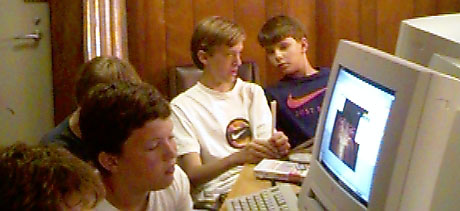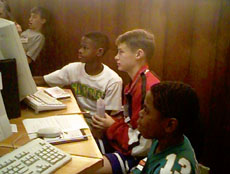|
July 17, 1997 The fourth day of the Internet Explorers Club began today at 8:30. Joseph South begain reviewing the previous day. In their review they talked about global chatting, Cu-SeeMe, and the collaborative snowflake model. After they completed their review the IEC students then were instructed to open their global chatting application. They briefly started a chat session among their fellow classmates. Next, Joe reviewed to the Internet Explorers about the video conferencing system. Then Joe conveyed the idea to the class about people called "lurkers". He proceed to tell the class that a "lurker" was a person who could watch you telecommunicate with other without their identity being revealed.
When the Internet Explorers finished reviewing, Thomas Dietz, instructed on how to finish their worksheets from the previous day. The students in the third session expeditiously finished those models which included: the Population Dynamics Model, the flu model, and a Java volcano model. After completing the models, Tom discussed the flu model for four different countries, especially Germany. Next, Tom explained to the extraordinary Internet Explorers the theory behind an asymptote. Thomas explained to them that an asymptote was a mathematical graph that never reached zero. The Explorers questioned this theory because in a flu it was inconceivable that half of a person could become sick. Thomas then contradicted that it was a mathematical model and it did not necessarily have be theoretically correct. Tom then explained to the Internet Explorers how the graph calculates the following variables in the flu model: the number of people susceptible, the number of people infected, and the number of people recovered. After completing the this activity, Tom held a discussion about virus and the environment. The Internet Explorers appeared to enjoy this session. Following this, Dr. Robert Panoff, Bob1, summarized the lesson from day three to the class about observations. He then reiterated this idea to the class. "What can we learn about observations," inquired Bob1. To prove this point, he divided them up into groups of four and distributed two boxes of straws among them (each from a different company). He then had them use their observation skills to determine the quantity of straws in the boxes. They could use the size of the box, the information displayed on the box, and any tool they had to use without actually opening the box. Finally, they opened the boxes and using their previous observation data compared it. They then all found out that NONE of the boxes contained just fifty straws. When they measured the straws with their rulers they also found out that NONE of the straws were exactly eight inches. Also, on the two different boxes of straws they found out that the default measurements on the boxes were incorrect.
After Bob1 finished with his observation activity Jonathan Pahl, started his lesson by having a discussion on the disease Ebola. They then wrote down the information on the board that they know about the Ebola virus. Jonathan then wrote the normal birth and death rates comparing it to the general population. The students then searched the Internet for additional information to complete a chat that they had made. The Internet Explorers left the Shodor Education Foundation with immense knowledge of modeling, close obbservation, and searching the Internet for information. Now, with the knowledge of the Internet and all of its potential, the Internet Explorers are ready for a new and ever-changing future.
Last Update: June 14, 1999 Please direct questions and comments about this page to WebMaster@shodor.org © Copyright 1998 The Shodor Education Foundation, Inc. |




